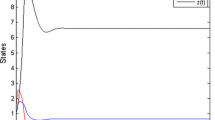Abstract
This article is concerned with the optimal harvesting of a predator–prey model with a prey refuge and imprecise biological parameters. We consider the model under impreciseness and introduce a parametric functional form of an interval which differs from those of models with precise biological parameters. The existence of all possible equilibria and stability of system are discussed. The bionomic equilibrium of the model is analyzed. Also, the optimal harvesting policy is derived using Pontryagin’s maximal principle. Numerical simulations are presented to verify the feasibilities of our analytical results.






Similar content being viewed by others
References
Alvarez LHR (1998) Optimal harvesting under stochastic fluctuations and critical depensation. Math Biosci 37:155–177
Barros LC, Bassanezi RC, Tonelli PA (2000) Fuzzy modelling in population dynamics. Ecol Model 128:27–33
Bassanezi RC, Barros LC, Tonelli PA (2000) Attractors and asymptotic stability for fuzzy dynamical systems. Fuzzy Set Syst 113:473–483
Cecconello MS, Bassanezi RC, Brandäo AJV, Leite J (2014) On the stability of fuzzy dynamical systems. Fuzzy Set Syst 248:106–121
Chen LJ, Chen FD, Chen LJ (2010) Qualitative analysis of a predator–prey model with Holling type II functional response incorporating a constant prey refuge. Nonlinear Anal RWA 11:246–252
Chen LJ, Chen FD, Wang YQ (2013) Influence of predator mutual interference and prey refuge on Lotka–Volterra predator–prey dynamics. Commun Nonlinear Sci Numer Simul 18:3174–3180
Clark CW (1985) Bioeconomic modelling and fisheries management. Wiley, New York
Clark CW (1976) Mathematical bioeconomics: the optimal management of renewable resources. Wiley, New York
Gause GF, Smaragdova NP, Witt AA (1936) Further studies of interaction between predators and prey. J Anim Ecol 5:1–18
Gkana A, Zachilas L (2013) Incorporating prey refuge in a prey–predator model with a Holling type I functional response: random dynamics and population outbreaks. J Biol Phys 39:587–606
Guo M, Xu X, Li R (2003) Impulsive functional differential inclusions and fuzzy population models. Fuzzy Sets Syst 138:601–615
Ji LL, Wu CQ (2010) Qualitative analysis of a predator–prey model with constant-rate prey harvesting incorporating a constant prey refuge. Nonlinear Anal RWA 11:2285–2295
Ko W, Ryu K (2006) Qualitative analysis of a predator–prey model with Holling type II functional response incorporating a prey refuge. J Differ Equ 231:534–550
Liu M, Bai CZ (2014) Optimal harvesting policy for a stochastic predator–prey model. Appl Math Lett 34:22–26
Liu M, Wang K (2013) Dynamics of a Leslie–Gower Holling-type II predator–prey system with L\(\acute{e}\)vy jumps. Nonlinear Anal Theory Methods Appl 85:204–213
Liu ZJ, Tan RH (2007) Impulsive harvesting and stocking in a Monod–Haldane functional response predator–prey system. Chaos Solitons Fractals 34:454–464
Mizukoshi MT, Barros LC, Bassanezi RC (2009) Stability of fuzzy dynamic systems. Int J Uncertain Fuzziness Knowl Based Syst 17:69–84
Olivares EG, Jiliberto RR (2003) Dynamic consequences of prey refuges in a simple model system: more prey, fewer predators and enhanced stability. Ecol Model 166:135–146
Pal D, Mahaptra GS (2014) A bioeconomic modeling of two-prey and one-predator fishery model with optimal harvesting policy through hybridization approach. Appl Math Comput 242:748–763
Pal D, Mahaptra GS, Samanta GP (2013) Optimal harvesting of prey–predator system with interval biological parameters: a bioeconomic model. Math Biosci 241:181–187
Peixoto M, Barros LC, Bassanezi RC (2008) Predator–prey fuzzy model. Ecol Model 214:39–44
Pontryagin LS, Boltyonsku VG, Gamkrelidre RV, Mishchenko EF (1962) The mathematical theory of optimal process. Wiley, New York
Qiu H, Lv JL, Wang K (2013) The optimal harvesting policy for non-autonomous populations with discount. Appl Math Lett 26:244–248
Sharma S, Samanta GP (2014) Optimal harvesting of a two species competition model with imprecise biological parameters. Nonlinear Dyn 77:1101–1119
Smith JM (1974) Models in ecology. Cambridge University Press, Cambridge
Song XY, Chen LS (2001) Optimal harvesting and stability for a two-species competitive system with stage structure. Math Biosci 170:173–186
Tang GY, Tang SY, Cheke RA (2014) Global analysis of a Holling type II predator–prey model with a constant prey refuge. Nonlinear Dyn 76:635–647
Tan RH, Liu ZJ, Guo SL, Xiang HL (2015) On a nonautonomous competitive system subject to stochastic and impulsive perturbations. Appl Math Comput 256:702–714
Wang Y, Wang JZ (2012) Influence of prey refuge on predator–prey dynamics. Nonlinear Dyn 67:191–201
Zhang XA, Chen LS, Neumann AU (2000) The stage-structured predator–prey model and optimal harvesting policy. Math Biosci 168:201–210
Acknowledgments
We would like to thank the referees for their careful reading of the original manuscript and their valuable comments and suggestions that greatly improved the presentation of this paper. The work is supported by the National Natural Science Foundation of China (Nos. 11261017, 11371161) and the State Foundation for Studying Abroad. The authors thank Professor Binxiang Dai for his many valuable ideas and discussions. Also, the authors are grateful to Professor Yiping Chen and Doctor Changcheng Xiang for their help in numerical simulations.
Author information
Authors and Affiliations
Corresponding author
Additional information
Communicated by Geraldo Diniz.
Rights and permissions
About this article
Cite this article
Wang, Q., Liu, Z., Zhang, X. et al. Incorporating prey refuge into a predator–prey system with imprecise parameter estimates. Comp. Appl. Math. 36, 1067–1084 (2017). https://doi.org/10.1007/s40314-015-0282-8
Received:
Revised:
Accepted:
Published:
Issue Date:
DOI: https://doi.org/10.1007/s40314-015-0282-8




